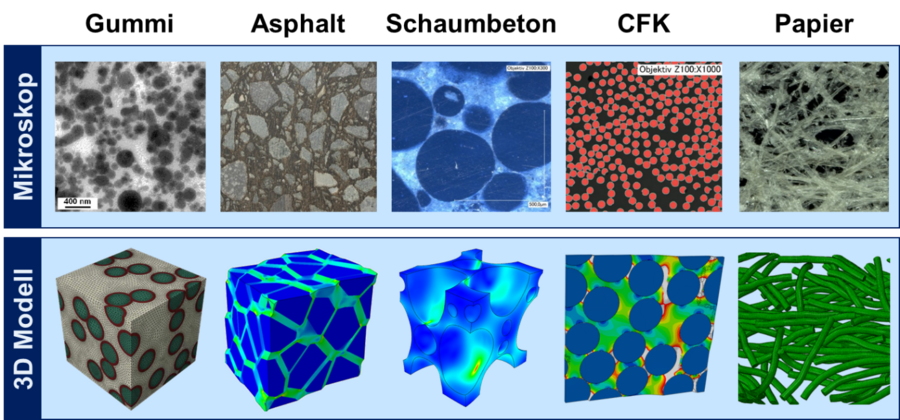International conference in Wuppertal
All-rounder with potential: paper in the focus of science

Paper can do a lot and even more: in terms of sustainability, increasing the material utilisation of paper is essential // Photo Colourbox
We all use it many times a day: a shot of milk in our morning coffee from the carton, receiving a long-awaited parcel or going to the toilet - we can't do without paper. The material is as much a material as an everyday object and offers plenty of scope for exciting research questions.
"Paper Physics" community as guests in Wuppertal
In cooperation with TU Darmstadt, the Wuppertal research group Computational Applied Mechanics (more information below) is organising the IPPC2024 conference, the International Paper Physics Conference. The team is expecting around 100 international experts from science and practice who will be discussing the topic of paper properties and material behaviour from different perspectives. They are coming from near and far from all over the world: from Austria and Sweden as well as Canada, the USA, China and Australia.
In over 70 presentations, the participants will exchange views on the fascinating world of paper: The conference programme will deal with the properties of cellulose fibres as well as the question of how folding processes affect coated paper , for example. The programme will also focus on energy-efficient recycling technologies and sustainability approaches in paper production.
Registration for the conference is still possible. The conference will be held in English. Birte Boes and her team of organisers will be happy to answer any questions by email at ippc2024[at]uni-wuppertal.de
Read on for more background

The basics of building with paper also need to be researched - in all phases, from the material to the building // Photo Colourbox
All-rounder with great potential: this is what makes paper research so relevant for the future
Paper plays a central role in many areas of everyday life. However, its production is still one of the most energy-intensive industries. On the one hand, companies in the industry are keen to find solutions that make the manufacturing process more climate-friendly. On the other hand, paper is a natural product that can be recycled and provides the best conditions for a sustainable circular economy. The more expertise there is about the material as such and the various techniques for handling it, the greater the chances of utilising the full potential of paper, including the development of new sustainable and bio-based materials.
Expertise from Wuppertal
At the University of Wuppertal, Prof Dr Jaan-Willem Simon 's team at the Chair of Computational Applied Mechanics is investigating the resilience of paper for a wide range of applications: In the packaging industry, for example, in cooperation with SIG, a leading global manufacturer of food and beverage packaging.
Computational applied mechanics: what's behind it?
"Basically, our research is concerned with describing the mechanical behaviour of materials and structures in various engineering applications using numerical models," reports Prof. Simon. For some time now, research has focussed on paper and cardboard. "The aim," adds the scientist, "is always to optimise the material and structural compositions in such a way that properties can be improved and resources conserved."
In the case of paper, which consists of cellulose fibres, the Wuppertal researchers are investigating their complex bonding and their behaviour under various conditions. For example, they are asking which stresses can cause paper to tear, or what happens when it is exposed to moisture and different temperatures (see "What the group is researching specifically"). To make this analysis as efficient as possible, they simulate the processes on the computer. This also saves a large number of experiments with real paper.
For the computer simulation to run, the right mathematical tool is needed, in this case suitable simulation models, and knowledge of the complex microstructure of the paper. "Depending on the type of paper and how it is used, we need a model that precisely reproduces the properties that the paper has in practical use," explains Simon. After all, there are around 3,000 different types of paper - packaging papers, graphic papers, hygiene papers, papers for technical and special applications. "Only with the right simulation model can we ensure that the results on the computer can be utilised and used as realistic predictions for practical applications," says the group leader.
His team develops such models themselves and then applies them in the simulation to answer both fundamental and applied research questions.

Actual microstructures of various composite materials (top) and the numerical models developed for their research in comparison // Graphic CAM Chair
What the group is actually researching
Prof Simon and his colleagues are currently conducting research with funding from the Federal Ministry for Economic Affairs and Climate Action, for example a digital platform for the design of sustainable lightweight composite materials based on wood fibres. The aim is to make better use of the lightweight construction potential of paper and cardboard, taking into account the influence of the unpredictable behaviour of the fibre network structure. The information is to be made publicly accessible via the platform.
Another project aims to contribute to increasing the usability of paper for sophisticated packaging solutions in the interests of sustainability. In particular, the influence of moisture during transport and storage processes, which is difficult to control, poses a significant problem for paper processing. "The lack of possibilities to control environmental conditions in all production and storage facilities and to design the machines and tools to suit the packaging prior to the paper forming process motivates the use of simulations," explains employee Nadir Kopic-Osmanovic. The aim of the project, funded by the German Federation of Industrial Research Associations (AiF), is to develop a capable simulation tool that is able to capture the material behaviour of paper, taking moisture and temperature into account.
Detailed models of the material are needed in order to better predict the service life and damage mechanisms of cardboard packaging, which have so far been largely misunderstood due to the complex fibre bonds. In a project funded by the German Research Foundation (DFG), Birte Boes has developed a special mathematical model that sheds more light on the subject and contributes to the understanding of different types of stress. It not only provides reliable explanations and predictions for paper and cardboard, but can also be applied to other materials with similar properties.
Growing: Group opens up further fields of application
A lot has happened since the research group started in the winter semester 2022/23 and the team is growing. In addition to paper, it is now also focussing on other fields, such as road construction. It is struggling with the fact that the asphalt is crumbling more and more in some places. In order to guarantee mobility in the future, it is desirable to maximise the useful life of roads and minimise repair work, traffic restrictions and personnel costs. "The current standard methods for the computational design of road surfaces are essentially several decades old and their scope of modelling is limited," explains Dr Johannes Neumann, who heads the research group together with Prof. Simon. It is therefore necessary to develop numerical simulation models that can be used as tools for the efficient development of new construction materials, but also for the further development of existing construction materials.
Overview: Further tasks of the research projects are summarised on the website.
